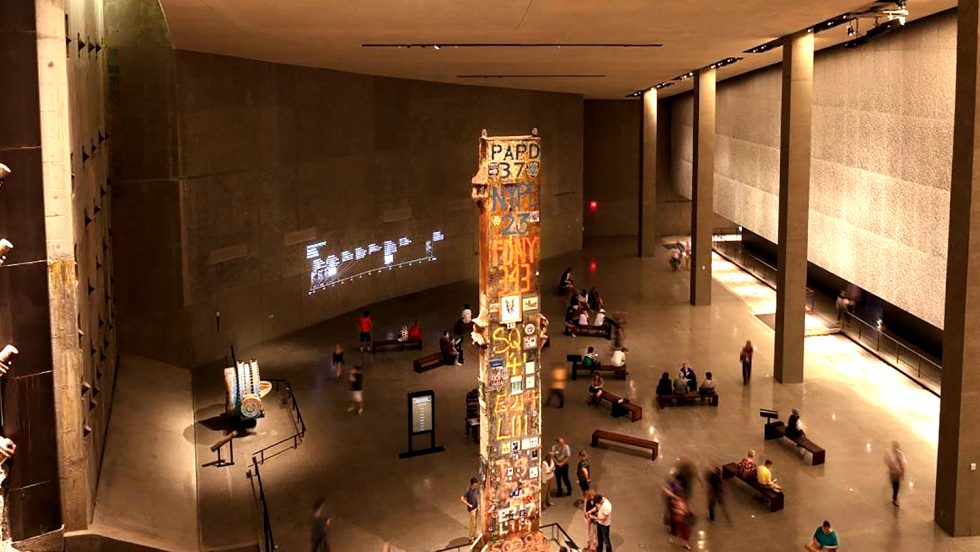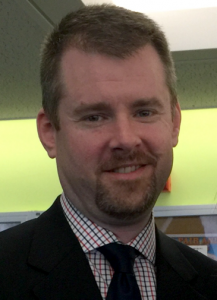
As the nation approaches the 20th anniversary of September 11, the 9/11 Memorial & Museum in New York City commemorates and honors those killed in the terrorist attacks of that day—as well as the earlier terrorist truck bomb attack that occurred on February 26, 1993—and the survivors and first responders, and recognizes the many ways in which the world came together in the aftermath.
The Memorial consists of two outdoor reflecting pools set in the footprints of the Twin Towers. The Museum, housed below the memorial, tells the story of September 11 through media, narratives, and a collection of monuments and artifacts. Visitors learn personal stories of loss, recovery and hope.
The person responsible for the visitor experience and leading the hundreds of staff members and more than 100 volunteers—many of whom are survivors and family members of those who died that day—is Chris Wogas, MBA ’09, senior vice president of visitor experience. He’s also in charge of the box office, retail, the café and e-commerce.

Chris Wogas, MBA ’09
A lifelong New Yorker, he began working at the Memorial & Museum in June 2017. Prior to that he was with Live Nation and remembers working at Jones Beach for the company on the day of the attacks. He said that when he had the opportunity to work at the 9/11 Memorial & Museum, it was an opportunity he didn’t want to miss.
Wogas, a former member of Adelphi’s Alumni Advisory Council, talks about what it’s like to work on the hallowed grounds of the worst terrorist attack in U.S. history, emphasizing, “We don’t just tell the events of 9/11; we also like to celebrate what we call 9/12, which is all the things that took place after that day.”
What is the most significant impact of your job for you?
It’s really a once-in-a-lifetime opportunity to be able to serve an institution like this, the people who work here and the visitors who interact with this space, [who] hear the stories, learn what happened, and then take a piece of that home with them, [then] tell somebody else and get them to come here and do the exact same thing.
Who tends to visit the site?
A significant number of people visit the Memorial and the Museum each year, but a lot of New Yorkers don’t. Not everybody’s ready for it. But once people do visit, even if they come to just the Memorial, I think they come away with a real connection, not only to what happened, but being in a site that is specifically meant to allow people to show their respect, connect with what happened and see how people rebuild. It’s just an interesting thing to think about, especially as we come to the 20th anniversary, that there are two parts to the experience and the Memorial itself is a significant reason for people to want to be here to pay their respects and interact with the space and the people.
As we approach the 20th anniversary, what’s happening there for you, your employees and the Museum?
The commemoration every year attracts a significant number of people in the weeks before, after and on the day of, as it should be. That the Memorial is open to family members only that morning is significant. It’s an honor to be able to take part in that ceremony and support those who were affected by the significant tragic loss. Every year, I’m reminded of how important it is that I get to be there that day and interact with those people.
What is it like to work in the Memorial & Museum?
It’s certainly an emotional place to work… . It requires significant support of the team and of each other. A significant portion of our volunteers were in the buildings, rescue recovery workers or involved with the efforts ongoing after the fact. [Emotions] run high continuously, whether it’s amongst the team or the people who visit. It just means there’s an element of self-care you have to be aware of for yourself and your team.
What in your MBA training do you think you take with you to this position?
All of what I learned has value, including hiring, managing and leading a team, as well as marketing.
Do you see parallels between 9/11 and COVID-19 in terms of how New Yorkers stayed strong through these two events?
I think resilience is a big part of the 9/11 story and I think we’re seeing that as a city and as a country and as a world relative specifically to COVID. You also see that likeness with the frontline workers.